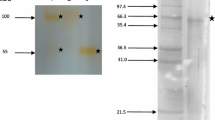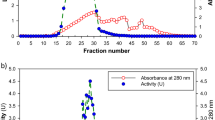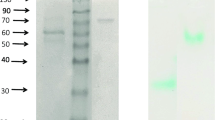Abstract
The white-rot fungus T. versicolor UAMH 8272 produced two groups of laccases, each of which included several isoforms showing different isoelectric points (pI). Group 1 and group 2 laccases, respectively, displayed higher pI 5–6 and lower pI 3–4. Of the four cloned full-length laccase cDNAs, Lac 1 and Lac 4 were expressed in the heterologous protein expression system using Aspergillus oryzae. The measured pI of each Lac 1 and Lac 4 expressed in A. oryzae was lower than that of pI predicted from the amino acid composition. With this regard, isoelectric focusing of Lac 1 showed the presence of multiple protein bands in the 3.0–4.0 pI range, although the predicted pI value of Lac 1 was 4.7. Similarly, Lac 4 exhibited a pI value which was lower than that predicted (3.6 vs. 4.3, respectively). In all tested hydroxyPCBs, higher chlorinated hydroxyPCBs were less susceptible to in vitro degradation by laccase than lower chlorinated hydroxyPCBs. Although Lac 4 showed a generally higher activity than Lac 1, the two laccases were characterized by quite different substrate specificity toward two hydroxy-tetrachlorobiphenyl congeners. Two metabolites were obtained from the metabolism of hydroxy-pentachlorobiphenyl: a ten chlorine-substituted dimer with a C–O bond, and one with a C–C bond.





Similar content being viewed by others
References
Barr DP, Aust SD (1994) Pollutant degradation by white rot fungi. Rev Environ Contam Toxicol 138:49–72
Bertrand T, Jolivalt C, Briozzo P, Caminade E, Joly N, Madzak C et al (2002) Crystal structure of a four-copper laccase complexed with an arylamine: insights into substrate recognition and correlation with kinetics. Biochemistry 41:7325–7333
Bourbonnais R, Paice MG (1990) Oxidation of non-phenolic substrates. An expanded role for laccase in lignin biodegradation. FEBS Lett 267:99–102
Buckman AH, Wong CS, Chow EA, Brown SB, Solomon KR, Fisk AT (2006) Biotransformation of polychlorinated biphenyls (PCBs) and bioformation of hydroxylated PCBs in fish. Aquat Toxicol 78:176–185
Cameron MD, Timofeevski S, Aust SD (2000) Enzymology of Phanerochaete chrysosporium with respect to the degradation of recalcitrant compounds and xenobiotics. Appl Microbiol Biotechnol 54:751–758
Collins PJ, Kotterman M, Field JA, Dobson A (1996) Oxidation of Anthracene and Benzo[a]pyrene by Laccases from Trametes versicolor. Appl Environ Microbiol 62:4563–4567
Fernandez MF, Kiviranta H, Molina-Molina JM, Laine O, Lopez-Espinosa MJ, Vartiainen T et al (2008) Polychlorinated biphenyls (PCBs) and hydroxy-PCBs in adipose tissue of women in southeast Spain. Chemosphere 71:1196–1205
Fukuda T, Uchida H, Takashima Y, Uwajima T, Kawabata T, Suzuki M (2001) Degradation of bisphenol A by purified laccase from Trametes villosa. Biochem Biophys Res Commun 284:704–706
Han MJ, Choi HT, Song HG (2004) Degradation of phenanthrene by Trametes versicolor and its laccase. J Microbiol 42:94–98
Hartley JL, Temple GF, Brasch MA (2000) DNA cloning using in vitro site-specific recombination. Genome Res 10:1788–1795
Hovander L, Linderholm L, Athanasiadou M, Athanassiadis I, Bignert A, Fangstrom B et al (2006) Levels of PCBs and their metabolites in the serum of residents of a highly contaminated area in eastern Slovakia. Environ Sci Technol 40:3696–3703
Jaspers VL, Dirtu AC, Eens M, Neels H, Covaci A (2008) Predatory bird species show different patterns of hydroxylated polychlorinated biphenyls (HO-PCBs) and polychlorinated biphenyls (PCBs). Environ Sci Technol 42:3465–3471
Johannes C, Majcherczyk A (2000) Natural mediators in the oxidation of polycyclic aromatic hydrocarbons by laccase mediator systems. Appl Environ Microbiol 66:524–528
Kamei I, Kogura R, Kondo R (2006) Metabolism of 4,4′-dichlorobiphenyl by white-rot fungi Phanerochaete chrysosporium and Phanerochaete sp. MZ142. Appl Microbiol Biotechnol 72:566–575
Kawano M, Hasegawa J, Enomoto T, Onishi H, Nishio Y, Matsuda M et al (2005) Hydroxylated polychlorinated biphenyls (OH-PCBs): recent advances in wildlife contamination study. Environ Sci 12:315–324
Keum YS, Li QX (2004) Fungal laccase-catalyzed degradation of hydroxy polychlorinated biphenyls. Chemosphere 56:23–30
Kim Y, Yeo S, Kim MK, Choi HT (2008) Removal of estrogenic activity from endocrine-disrupting chemicals by purified laccase of Phlebia tremellosa. FEMS Microbiol Lett 284:172–175
Kimura-Kuroda J, Nagata I, Kuroda Y (2005) Hydroxylated metabolites of polychlorinated biphenyls inhibit thyroid-hormone-dependent extension of cerebellar Purkinje cell dendrites. Brain Res Dev Brain Res 154:259–263
Kitamura S, Jinno N, Suzuki T, Sugihara K, Ohta S, Kuroki H, Fujimoto N (2005) Thyroid hormone-like and estrogenic activity of hydroxylated PCBs in cell culture. Toxicology 208:377–387
Kubatova A, Erbanova P, Eichlerova I, Homolka L, Nerud F, Sasek V (2001) PCB congener selective biodegradation by the white rot fungus Pleurotus ostreatus in contaminated soil. Chemosphere 43:207–215
Kumar SV, Phale PS, Durani S, Wangikar PP (2003) Combined sequence and structure analysis of the fungal laccase family. Biotechnol Bioeng 83:386–394
Kunisue T, Sakiyama T, Yamada TK, Takahashi S, Tanabe S (2007) Occurrence of hydroxylated polychlorinated biphenyls in the brain of cetaceans stranded along the Japanese coast. Mar Pollut Bull 54:963–973
Landy A (1989) Dynamic, structural, and regulatory aspects of lambda site-specific recombination. Annu Rev Biochem 58:913–949
Mayer AM, Staples RC (2002) Laccase: new functions for an old enzyme. Phytochemistry 60:551–565
Minetoki T, Kumagai C, Gomi K, Kitamoto K, Takahashi K (1998) Improvement of promoter activity by the introduction of multiple copies of the conserved region III sequence, involved in the efficient expression of Aspergillus oryzae amylase-encoding genes. Appl Microbiol Biotechnol 50:459–467
Otake T, Yoshinaga J, Enomoto T, Matsuda M, Wakimoto T, Ikegami M et al (2007) Thyroid hormone status of newborns in relation to in utero exposure to PCBs and hydroxylated PCB metabolites. Environ Res 105:240–246
Piontek K, Antorini M, Choinowski T (2002) Crystal structure of a laccase from the fungus Trametes versicolor at 1.90-Å resolution containing a full complement of coppers. J Biol Chem 277:37663–37669
Sandala GM, Sonne-Hansen C, Dietz R, Muir DC, Valters K, Bennett ER, Born EW, Letcher RJ (2004) Hydroxylated and methyl sulfone PCB metabolites in adipose and whole blood of polar bear (Ursus maritimus) from east Greenland. Sci Total Environ 331:125–141
Sanger F, Coulson AR (1975) A rapid method for determining sequences in DNA by primed synthesis with DNA polymerase. J Mol Biol 94:441–448
Schultz A, Jonas U, Hammer E, Schauer F (2001) Dehalogenation of chlorinated hydroxybiphenyls by fungal laccase. Appl Environ Microbiol 67:4377–4381
Soares A, Jonasson K, Terrazas E, Guieysse B, Mattiasson B (2005) The ability of white-rot fungi to degrade the endocrine-disrupting compound nonylphenol. Appl Microbiol Biotechnol 66:719–725
Soechitram SD, Athanasiadou M, Hovander L, Bergman A, Sauer PJ (2004) Fetal exposure to PCBs and their hydroxylated metabolites in a Dutch cohort. Environ Health Perspect 112:1208–1212
Takagi S, Shirota C, Sakaguchi K, Suzuki J, Sue T, Nagasaka H, Hisamatsu S et al (2007) Exoenzymes of Trametes versicolor can metabolize coplanar PCB congeners and hydroxy PCB. Chemosphere 67:S54–S57
Tsuboi H, Koda A, Toda T, Minetoki T, Hirotsune M, Machida M (2005) Improvement of the Aspergillus oryzae enolase promoter (P-enoA) by the introduction of cis-element repeats. Biosci Biotechnol Biochem 69:206–208
Ueno D, Darling C, Alaee M, Campbell L, Pacepavicius G, Teixeira C, Muir D (2007) Detection of hydroxylated polychlorinated biphenyls (OH-PCBs) in the abiotic environment: surface water and precipitation from Ontario, Canada. Environ Sci Technol 41:1841–1848
Ullah MA, Bedford CT, Evans CS (2000) Reactions of pentachlorophenol with laccase from Coriolus versicolor. Appl Microbiol Biotechnol 53:230–234
Van Aken B, Hofrichter M, Scheibner K, Hatakka AI, Naveau H, Agathos SN (1999) Transformation and mineralization of 2,4,6-trinitrotoluene (TNT) by manganese peroxidase from the white-rot basidiomycete Phlebia radiata. Biodegradation 10:83–91
Xu F, Kulys JJ, Duke K, Li K, Krikstopaitis K, Deussen HJ, Abbate E, Galinyte V, Schneider P (2000) Redox chemistry in laccase-catalyzed oxidation of N-hydroxy compounds. Appl Environ Microbiol 66:2052–2056
You SH, Gauger KJ, Bansal R, Zoeller RT (2006) 4-Hydroxy-PCB106 acts as a direct thyroid hormone receptor agonist in rat GH3 cells. Mol Cell Endocrinol 257–258:26–34
Acknowledgements
We thank Drs. Jun Suzuki and Kazuko Sakaguchi of Azabu University for the technical assistance in isoelectric electrophoresis of laccases. We also thank Ozeki Corp. for providing the heterologous protein expression system using A. oryzae.
Author information
Authors and Affiliations
Corresponding author
Rights and permissions
About this article
Cite this article
Fujihiro, S., Higuchi, R., Hisamatsu, S. et al. Metabolism of hydroxylated PCB congeners by cloned laccase isoforms. Appl Microbiol Biotechnol 82, 853–860 (2009). https://doi.org/10.1007/s00253-008-1798-2
Received:
Revised:
Accepted:
Published:
Issue Date:
DOI: https://doi.org/10.1007/s00253-008-1798-2




